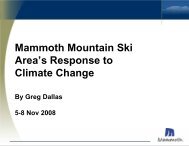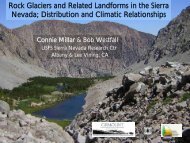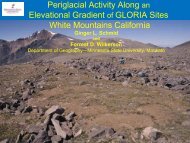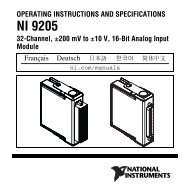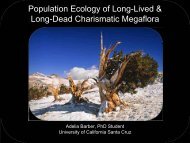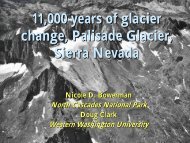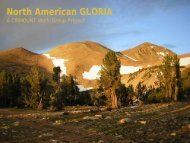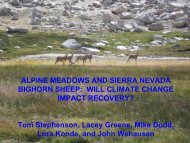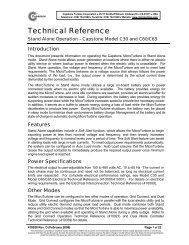Potential Effects of Climate Change on High Elevation Amphibians ...
Potential Effects of Climate Change on High Elevation Amphibians ...
Potential Effects of Climate Change on High Elevation Amphibians ...
- No tags were found...
You also want an ePaper? Increase the reach of your titles
YUMPU automatically turns print PDFs into web optimized ePapers that Google loves.
<str<strong>on</strong>g>Potential</str<strong>on</strong>g> <str<strong>on</strong>g>Effects</str<strong>on</strong>g> <str<strong>on</strong>g>of</str<strong>on</strong>g> <str<strong>on</strong>g>Climate</str<strong>on</strong>g><str<strong>on</strong>g>Change</str<strong>on</strong>g> <strong>on</strong> <strong>High</strong> Elevati<strong>on</strong><strong>Amphibians</strong> and Reptiles in theSierra NevadaCarrie Sendak and Kathleen MatthewsUSFS Pacific SW Research Stati<strong>on</strong>Sierra Nevada Research CenterAlbany, CA
Species• Pacific chorus frog (Pseudacrisregilla)- Formerly Pacific treefrog (Hylaregilla)- Widely distributed- Adults highly terrestrial- “Quick” breeders (2-3 m<strong>on</strong>ths tometamorphosis)- No state or federal statusGary NafisGary Nafis
Species• Formerly: Mountainyellow-legged frog(Rana muscosa)• Currently 2 species:– Sierra Nevada mountain(Rana sierrae)– Sierra Madre or Southernmountain (Rana muscosa)(Vredenburg et al. 2007)csendakkmatthews
RASI / RAMUDistributi<strong>on</strong>• C<strong>on</strong>tact z<strong>on</strong>e– Middle and South ForkKings River– Kings Cany<strong>on</strong> Nati<strong>on</strong>alParkFrom: Vredenburg et al. 2007
More <strong>on</strong> RASI / RAMU• Breeds in alpine lakes or slowmovingstreams• Tadpoles overwinter in lakes -2-4 year larval stage• <strong>High</strong>ly aquatic (all life stages)• Status:- DFG – Special C<strong>on</strong>cern- USFS – Sensitive- Found warranted for federal ESAlistingcsendakGary Nafis
Species• Southern l<strong>on</strong>g-toedsalamander (Ambystomamacrodactylum sigillatum)• At higher elevati<strong>on</strong>s,breeds in permanent p<strong>on</strong>dsor lakes• 2-3 year larval stage• No state or federal statusGary NafisGary Nafis
Amphibian Declines• Habitat Fragmentati<strong>on</strong>• Pesticides / Herbicides• Introduced, Invasive Species• Disease• <str<strong>on</strong>g>Climate</str<strong>on</strong>g> <str<strong>on</strong>g>Change</str<strong>on</strong>g>
How Does <str<strong>on</strong>g>Climate</str<strong>on</strong>g> <str<strong>on</strong>g>Change</str<strong>on</strong>g> Play aRole?
Predicted <str<strong>on</strong>g>Effects</str<strong>on</strong>g> for the Sierra Nevada• Increase in temperature (anywhere from 2-6°)• 50 - 90% decrease in snowpack by 2099• Increase in precipitati<strong>on</strong> fallen as rain• Earlier spring snowmelt• Several models, variable predicti<strong>on</strong>s• <strong>High</strong> elevati<strong>on</strong> predicti<strong>on</strong>s still need moreresearch
<str<strong>on</strong>g>Change</str<strong>on</strong>g>s in Snow-WaterEquivalentFrom: Knowles and Cayan 2002
Seas<strong>on</strong>al <str<strong>on</strong>g>Effects</str<strong>on</strong>g> <strong>on</strong> Precipitati<strong>on</strong>SummerWinterFrom Leung et al. 2004
<str<strong>on</strong>g>Change</str<strong>on</strong>g>s in Timing <str<strong>on</strong>g>of</str<strong>on</strong>g> Spring SnowmeltFrom: Stewart et al. 2004
What does this Mean for <strong>High</strong>Elevati<strong>on</strong> <strong>Amphibians</strong>?• <str<strong>on</strong>g>Effects</str<strong>on</strong>g> will vary for different species• Reduced larval recruitment (more sinkhabitats)• Interacti<strong>on</strong> <str<strong>on</strong>g>of</str<strong>on</strong>g> n<strong>on</strong>native trout andreduced recruitment• Shifts in breeding phenology?
Water Availability vs. Recruitment
Dusy Basin, Kings Cany<strong>on</strong>From: Lacan et al. 2008
Reduced Recruitment inOverwintering Larval SpeciesAbundance <str<strong>on</strong>g>of</str<strong>on</strong>g> RASIlarva in all lakes (DusyBasin, Kings Cany<strong>on</strong>,1997-2008)• in seas<strong>on</strong>al ( ) vs.permanent lakesLarval Abundance1400120010008006004002001st YearPre-Mets01 2 3 4 5 6 7 8 9 10 11 12 20 21 22Lakes
Recruitment (lack there<str<strong>on</strong>g>of</str<strong>on</strong>g>)• Increase in lake drying =less aquatic-stage survivalto metamorphosis• Increase in “sink” habitats• Mtn. yellow-legged frogoccurrence associatedwith deeper lakes, but…csendakFrom: Knapp2005
<str<strong>on</strong>g>Effects</str<strong>on</strong>g> <str<strong>on</strong>g>of</str<strong>on</strong>g> N<strong>on</strong>native TroutDusy Basin, Kings Cany<strong>on</strong>• in fish ( ) vs. fishless lakes (1997-2008)140012001st YearPre-MetsLarval Abundance100080060040020001 2 3 4 5 6 7 8 9 10 11 12 20 21 22Lakes
<str<strong>on</strong>g>Effects</str<strong>on</strong>g> <str<strong>on</strong>g>of</str<strong>on</strong>g> N<strong>on</strong>native Trout• L<strong>on</strong>g-toed salamander densities in stocked vs.fishless lakesFrom: Pilliod2001
Would the <strong>Amphibians</strong>’ BreedingShift with Fish Removal?• Density <str<strong>on</strong>g>of</str<strong>on</strong>g> RAMU afterfish removal in KCNP• Possible l<strong>on</strong>g-term shift<str<strong>on</strong>g>of</str<strong>on</strong>g> gravid females to“more” permanent lakesif fish were removed =increase recruitmentFrom: Knapp et al. 2007
From: Corn2003Breeding Phenology• Timing <str<strong>on</strong>g>of</str<strong>on</strong>g> snowmeltlinked to amphibianbreeding• Shift to earlier breedinghas been documentedin some species
What about Reptiles?• Mountain GarterSnake (Thamnophiselegans elegans)• Wandering GarterSnake (Thamnophiselegans vagrans)csendak• Sierra Garter Snake(Thamnophis couchii)Gary NafisGary Nafis
Mountain and Wandering Garter Snakes• Intergrades <str<strong>on</strong>g>of</str<strong>on</strong>g> Mountain andWandering garter snakes• Occupy variety <str<strong>on</strong>g>of</str<strong>on</strong>g> habitats, includinghigh elevati<strong>on</strong> meadows and lakes up to13000ft
Sierra Garter Snake• Primarily found in midto higher elevati<strong>on</strong>streams and rivers• Can occur inmeadows and lakes• Found up to 8000 ft
<str<strong>on</strong>g>Potential</str<strong>on</strong>g> Indirect <str<strong>on</strong>g>Effects</str<strong>on</strong>g> <str<strong>on</strong>g>of</str<strong>on</strong>g><str<strong>on</strong>g>Climate</str<strong>on</strong>g> <str<strong>on</strong>g>Change</str<strong>on</strong>g> <strong>on</strong> GarterSnakes
Predictor Variables for Occurrence• Mountain Yellow-legged–NO fish– Deeper water• Mountain Garter Snake– All <str<strong>on</strong>g>of</str<strong>on</strong>g> the above + AMPHIBIANS
Yum, dinner! Just alittle closer froggy…Ahh, sun andwarm water!csendak
C<strong>on</strong>clusi<strong>on</strong>s• The <str<strong>on</strong>g>Climate</str<strong>on</strong>g>’s A Changin’ in the SierraNevada• Uncertainty <str<strong>on</strong>g>of</str<strong>on</strong>g> the level <str<strong>on</strong>g>of</str<strong>on</strong>g> impacts <strong>on</strong> highelevati<strong>on</strong>• Possible reduced recruitment if lakes startdrying more <str<strong>on</strong>g>of</str<strong>on</strong>g>ten or too quickly• Combined with n<strong>on</strong>native fish effects couldmean trouble for both amphibians andreptiles unless…
C<strong>on</strong>servati<strong>on</strong>• …N<strong>on</strong>native fish removal <str<strong>on</strong>g>of</str<strong>on</strong>g> permanentlakes where amphibians have a goodlikelihood to breed
Current and Future Studies• L<strong>on</strong>g-term m<strong>on</strong>itoring <str<strong>on</strong>g>of</str<strong>on</strong>g> RASI in DusyBasin, Kings Cany<strong>on</strong> NP– Egg mass depositi<strong>on</strong>– Abundance and recruitment– <str<strong>on</strong>g>Climate</str<strong>on</strong>g> (SWE, temp, precipitati<strong>on</strong>)– Lake levels– P/A <str<strong>on</strong>g>of</str<strong>on</strong>g> Garter Snakes• Fish removal experiments in Dusy?
Stewart, I. T., D. R. Cayan, and M. D. Dettinger. 2004. <str<strong>on</strong>g>Change</str<strong>on</strong>g>s in Snowmelt Run<str<strong>on</strong>g>of</str<strong>on</strong>g>f Timing in Western North America Undera 'Business As Usual' <str<strong>on</strong>g>Climate</str<strong>on</strong>g> <str<strong>on</strong>g>Change</str<strong>on</strong>g> Scenario. Climatic <str<strong>on</strong>g>Change</str<strong>on</strong>g> 62:217-232.ReferencesCorn, P. S. 2003. <strong>Amphibians</strong> and <str<strong>on</strong>g>Climate</str<strong>on</strong>g> <str<strong>on</strong>g>Change</str<strong>on</strong>g>: Importance <str<strong>on</strong>g>of</str<strong>on</strong>g> Snow in the Mountains. C<strong>on</strong>servati<strong>on</strong> Biology 17:622-625.Corn, P. S. 2005. <str<strong>on</strong>g>Climate</str<strong>on</strong>g> <str<strong>on</strong>g>Change</str<strong>on</strong>g> and <strong>Amphibians</strong>. Animal Biodiversity and C<strong>on</strong>servati<strong>on</strong> 28:59-67.Knapp, R. A., D. M. Boiano, and V. T. Vredenburg. 2007. Removal <str<strong>on</strong>g>of</str<strong>on</strong>g> N<strong>on</strong>native Fish Results in Populati<strong>on</strong> Expansi<strong>on</strong> <str<strong>on</strong>g>of</str<strong>on</strong>g> aDeclining Amphibian (Mountain Yellow-legged Frog, Rana muscosa). Biological C<strong>on</strong>servati<strong>on</strong> 135:11-20.Knapp, R. 2005. <str<strong>on</strong>g>Effects</str<strong>on</strong>g> <str<strong>on</strong>g>of</str<strong>on</strong>g> N<strong>on</strong>native Fish and Habitat Characteristics <strong>on</strong> Lentic Herpet<str<strong>on</strong>g>of</str<strong>on</strong>g>uana in Yosemite Nati<strong>on</strong>al Park.Biological C<strong>on</strong>servati<strong>on</strong> 121:265-279.Knowles, N., and D. R. Cayan. 2002. <str<strong>on</strong>g>Potential</str<strong>on</strong>g> <str<strong>on</strong>g>Effects</str<strong>on</strong>g> <str<strong>on</strong>g>of</str<strong>on</strong>g> Global Warming <strong>on</strong> the Sacramento/San Joaquin Watershed and theSan Francisco Estuary. Geophysical Research Letters 29:38.31-38.34.Knowles, N., M. D. Dettinger, and D. R. Cayan. 2006. Trends in Snowfall Versus Rainfall in the Western United States.Journal <str<strong>on</strong>g>of</str<strong>on</strong>g> <str<strong>on</strong>g>Climate</str<strong>on</strong>g> 19:4545-4559.Lacan, I., K. Matthews, and K. Feldman. 2008. Interacti<strong>on</strong> <str<strong>on</strong>g>of</str<strong>on</strong>g> an Introduced Predator with Future <str<strong>on</strong>g>Effects</str<strong>on</strong>g> <str<strong>on</strong>g>of</str<strong>on</strong>g> <str<strong>on</strong>g>Climate</str<strong>on</strong>g> <str<strong>on</strong>g>Change</str<strong>on</strong>g> inthe Recruitment Dynamics <str<strong>on</strong>g>of</str<strong>on</strong>g> the Imperiled Sierra Nevada Yellow-legged Frog (Rana sierrae). Herpetological C<strong>on</strong>servati<strong>on</strong>and Biology.Leung, L. R., Y. Qian, X. Bian, W. M. Washingt<strong>on</strong>, J. Han, and J. O. Roads. 2004. Mid-Century Ensemble Regi<strong>on</strong>al <str<strong>on</strong>g>Climate</str<strong>on</strong>g><str<strong>on</strong>g>Change</str<strong>on</strong>g> Scenarios for the Western United States. Climatic <str<strong>on</strong>g>Change</str<strong>on</strong>g> 62:75-113.Matthews, K. R., R. A. Knapp, and K. L. Pope. 2002. Garter Snake Distributi<strong>on</strong> in <strong>High</strong>-Elevati<strong>on</strong> Aquatic Ecosystems: IsThere a Link with Declining Amphibian Populati<strong>on</strong>s and N<strong>on</strong>native Trout Introducti<strong>on</strong>s? Journal <str<strong>on</strong>g>of</str<strong>on</strong>g> Herpetology 36:16-22.McCabe, G. J. 1999. General-Circulati<strong>on</strong>-Model Simulati<strong>on</strong>s <str<strong>on</strong>g>of</str<strong>on</strong>g> Future Snowpack in the Western United States. Journal <str<strong>on</strong>g>of</str<strong>on</strong>g> theAmerican Water Resources Associati<strong>on</strong> 35:1473-1484.Pilliod, D. S. P., Charles R. 2001. Local and Landscape <str<strong>on</strong>g>Effects</str<strong>on</strong>g> <str<strong>on</strong>g>of</str<strong>on</strong>g> Introduced Trout <strong>on</strong> <strong>Amphibians</strong> in Historically FishlessWatersheds. Ecosystems 4:322-333.



